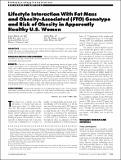| dc.contributor.author | Ahmad, Tariq | |
| dc.contributor.author | Lee, I-Min | |
| dc.contributor.author | Paré, Guillaume | |
| dc.contributor.author | Chasman, Daniel Ian | |
| dc.contributor.author | Rose, Lynda | |
| dc.contributor.author | Ridker, Paul M. | |
| dc.contributor.author | Mora, Samia | |
| dc.date.accessioned | 2013-02-22T19:22:32Z | |
| dc.date.issued | 2011 | |
| dc.identifier.citation | Ahmad, Tariq, I-Min Lee, Guillaume Paré, Daniel I. Chasman, Lynda Rose, Paul M. Ridker, and Samia Mora. 2011. Lifestyle interaction with fat mass and obesity-associated (FTO) genotype and risk of obesity in apparently healthy U.S. women. Diabetes Care 34(3): 675-680. | en_US |
| dc.identifier.issn | 0149-5992 | en_US |
| dc.identifier.uri | http://nrs.harvard.edu/urn-3:HUL.InstRepos:10336899 | |
| dc.description.abstract | Objective: Variation in the fat mass and obesity-associated (FTO) gene is associated with obesity. The extent to which separate and combined effects of physical activity and caloric intake modify this association remains unclear. Research Design and Methods: FTO polymorphism rs8050136 was measured, and physical activity, caloric intake, and anthropometrics were self-reported in 21,675 apparently healthy Caucasian women. Results: The effect of the risk allele (A) on BMI was larger among inactive or higher intake women, with additive effects of inactivity and high intake on the associated genetic risk. Specifically, each A allele was associated with mean BMI difference of +0.73 (SE 0.08) kg/m\(^2\) among inactive women (\(\leq\)median, 8.8 MET-hours/week), compared with +0.31 (0.06) kg/m\(^2\), P < 0.0001, among active women (>8.8 MET-hours/week). Similarly, each A allele was associated with mean BMI difference of +0.65 (0.07) among high intake women (>median, 1,679 kcals/day), compared with +0.38 (0.07) kg/m\(^2\), P = 0.005, among low intake women (\(\leq\)1,679 kcals/day). Among inactive/high intake women, each A allele was associated with mean BMI difference of +0.97 (0.11) kg/m\(^2\) vs. +0.22 (0.08) kg/m\(^2\) among inactive/low intake women, P < 0.0001. Among inactive/high intake women, each A allele carried increased risk of obesity (odds ratio 1.39, 95% CI 1.27–1.52) and diabetes (odds ratio 1.36, 95% CI 1.07–1.73). Conclusions: In this study, lifestyle factors modified the genetic risk of FTO on obesity phenotypes, particularly among women who were both inactive and had high intake. Healthier lifestyle patterns blunted but did not completely eliminate the associated genetic risk. | en_US |
| dc.language.iso | en_US | en_US |
| dc.publisher | American Diabetes Association | en_US |
| dc.relation.isversionof | doi:10.2337/dc10-0948 | en_US |
| dc.relation.hasversion | http://www.ncbi.nlm.nih.gov/pmc/articles/PMC3041206/pdf/ | en_US |
| dash.license | LAA | |
| dc.subject | Pathophysiology/Complications | en_US |
| dc.title | Lifestyle Interaction With Fat Mass and Obesity-Associated (FTO) Genotype and Risk of Obesity in Apparently Healthy U.S. Women | en_US |
| dc.type | Journal Article | en_US |
| dc.description.version | Version of Record | en_US |
| dc.relation.journal | Diabetes Care | en_US |
| dash.depositing.author | Lee, I-Min | |
| dc.date.available | 2013-02-22T19:22:32Z | |
| dc.identifier.doi | 10.2337/dc10-0948 | * |
| dash.contributor.affiliated | Mora, Samia | |
| dash.contributor.affiliated | Lee, I-Min | |
| dash.contributor.affiliated | Chasman, Daniel | |
| dash.contributor.affiliated | Ridker, Paul | |
| dc.identifier.orcid | 0000-0002-1083-6907 | |
| dc.identifier.orcid | 0000-0003-1249-4522 | |


